introduction

introduction
As early as the beginning of the 19th century, Mayer Rothschild (Mayer Rothschild) sent his five sons from Frankfurt to various places and established branches in London, Paris, Vienna and Naples. Using carrier pigeons, messengers, and chartered ships, they built a message network that carried messages across Europe at uncanny speed. Through this network, the Rothschilds were able to receive news and information faster than anyone else, and use this information to profit in arbitrage and trading. In one famous incident, Nathan Rothschild (Nathan Rothschild) got the news of Napoleon's defeat at Waterloo through his own information network a full 36 hours before the official London courier.
In all markets, information is valuable. And the competition for privileged access to information is fierce. Even in today's traditional markets, high-frequency trading firms and hedge funds spend billions of dollars building towers and cables around the world, hoping to gain an information advantage by a fraction of a millisecond through an arms race.
The crypto industry is no exception. On-chain, competition for access to order flow and order ordering has intensified. The concept of "Maximum Extractable Value" (or MEV for short) has grown from a niche topic to the forefront of nearly every cryptographic protocol. We’re seeing a growing conversation within the community about MEV’s impact on protocol transparency, sustainability, decentralization, security, censorship resistance, valuation, and more.
We discuss several key themes of MEV in this report. First we'll introduce MEV and why it's important. We then outline why we believe MEV is a fundamental building block and the trade-offs involved in managing MEV. We will also summarize the current state of MEVs and some of the key players in the field. Finally, we discuss future trends and open issues.
Key Takeaways:
● Understanding MEV is important.MEV affects security, stability, and user experience. MEV is also a key component in enabling blockchain tokens to add value. Most importantly, MEV affects two fundamental properties of blockchain networks: decentralization and censorship resistance.
● MEV is the fundamental constituent element.While there are solutions that can replace some forms of MEV, eventually there will always be a certain amount of MEV. The blockchain network is a double-edged sword, it brings an unlimited and decentralized smart contract platform, and it brings more MEV. Both protocols and applications require careful consideration and trade-offs when dealing with MEV.
● We estimate that on Ethereum under PoW, MEV has accounted for at least 5.8% of total miner revenue since 2020. Major MEV opportunities such as arbitrage, liquidations, and sandwich attacks are all highly competitive and consolidated by a small number of searchers.
● Although today everyone thinks that the impact of cross-chain MEV may be negligible, cross-chain MEV may form a highly concentrated force to affect all blockchains. The threat of multi-block MEV to the stability of the blockchain network is far away but will become increasingly serious.
● We can foreseePayment for Order Flow (PFOF) or Transaction Flow Auctionwill appear, which will return a certain amount of MEV to the user. In such scenarios, the most likely trend may be that block builders will become more centralized and reduce the rewards of validators, but more research is needed on how to do so in the future.
access memory pool
MEV was originally developed by Daian et al. in their seminal study reportingFlash Boys 2.0defined in . Originally discovered by researchers who had multiple bots competing with each other to prioritize transactions on Ethereum, the researchers investigated this and detailed the impact this had on the blockchain. The paper is also the first to define MEV as "the total amount of value an ethereum miner can extract by manipulating transactions over a given time frame, which may include transaction values across multiple blocks."
That sounds like a mouthful. To better understand MEV and understand how MEV is generated from first principles, let's look at the whole process of a simple Ethereum transaction.
The whole process of an Ethereum transaction
Suppose Joe wants to exchange 100 ETH for USDC on a decentralized exchange. Joe comes to the Uniswap front end and connects his MetaMask wallet. He enters the specifics of the transaction — 1,000 ETH for 1,300,000 USDC with 1.0% slippage — and signs the transaction.
His transaction is first sent via MetaMask's default RPC endpoint toInfura. Infura propagates this transaction request to other nodes in the Ethereum network, and these nodes similarly propagate the request to the nodes they are connected to.
Each validator has its own mempool, which is a database where each validator maintains its pending transactions. Validators build transaction blocks based on their own mempool. Typically, these transactions are ordered by gas fee. Alternatively, validators can run custom software to order transactions according to their own rules and logic.
The Ethereum network randomly selects a validator every 12 seconds to build and submit a block of transactions. The transaction block submitter broadcasts this new block to the network. The network will randomly select a committee of other validators to determine the validity of the block and create proofs for it. After the transaction is submitted, it will be deleted from the memory pool of the node.
How MEVs are generated
Memory pools are visible to everyone. Because Joe's transaction is submitted publicly, the following potential profit opportunities are created:
● Sandwich attack:Joe's exchange transaction set a slippage of 1%, which is not usually large. Although Joe wants to convert to $1,300,000, he signals to the world that he can accept $1,287,000. Other entities monitoring the mempool will see this high tolerance of Joe and try to "sandwich" him, taking a risk-free profit by giving Joe the worst execution price. They realized arbitrage by selling ETH ahead of Joe (front-running trading), so that Joe could sell at the floor price he defined, and then buy back ETH at a relatively low price.
● Arbitrage:After Joe completes the trade, there will be a temporary ETH-USDC price difference between Uniswap and other DEXs. There are bots that are constantly looking for these discrepancies and automatically execute the arbitrage (roll back the trade) after Joe's trade for a risk-free profit.
Validators have a privileged position to extract this profit.Because Ethereum's consensus protocol only enforces agreement at the block level, this allows validators to decide what happens within each block.Thus, validators can decide which transactions to include and the order in which those transactions are executed.
For example, suppose there is $100 in arbitrage space on a DEX. Alice will attempt to capture this profit by submitting a transaction, offering to pay a transaction fee of $1. But at the same time, the mempool is visible to everyone. So Bob sees Alice's transaction in the mempool, copies her transaction and offers to pay the $2 gas fee. Others may similarly flood the deal.
If left unmanaged, this profit motive can incentivize users to establish agreements with validators or miners off-chain to ensure that transactions get included or ordered. Alternatively, a validator or miner might submit transactions and prioritize their own transactions, capturing the entire $100 arbitrage profit.
Hence, the concept is called "maximal extractable value", or MEV for short. This concept used to be called "miner extractable value", but with the transition of Ethereum to PoS and the growing market share of PoS-based blockchains, the concept of "maximum extractable value" gained acceptance.
MEV supply chain
From the whole process of the transaction above, we can summarize a MEV supply chain. As a frame of reference, this supply chain can help us understand the various stakeholders in the ecosystem, MEV generation, and how best to mitigate and manage MEV.
source:

source:Flashbots
● User:Anyone who wants to change the state of the blockchain by expressing and committing intent.
● Wallet or application:A user interface that translates user intent into blockchain transactions.
● Searched by:Get MEV entities by monitoring the mempool and submitting transactions.
● Builder:Aggregate transactions from everywhere and create a complete block, ideally creating a block that maximizes rewards.
● Validator:Perform consensus duties such as committing blocks and attesting blocks.
Define MEVs
Consider the latest MEV definition under PoS blockchains:
The total value a validator is able to extract from a block (or series of blocks), considering the state of the environment and all available actions.
Validators generally cannot change the state of their environment. This includes the rules of the blockchain, the smart contract code on the blockchain, the combination of transactions in its mempool, etc.
Actions available here include reordering, reviewing, and inserting transactions. It also includes more niche tactics such as changing block timestamps, manipulating "randomness", DOSing other validators, etc.
MEV type
The three most competitive MEV profit channels are arbitrage, liquidation, and sandwich attacks. Below we outline these three approaches, along with some other interesting niche MEV opportunities, to better understand MEV.
arbitrage
Arbitrage is the largest source of MEV revenue. MEV exists because transaction ordering matters.
Arbitrage transactions occur in all markets. Whereas arbitrageurs in traditional markets face inventory risk or timing risk, many MEV arbitrages can be automated. Either all desired arbitrage trades are executed with a risk-free profit, or none of the trades are executed. And atomic arbitrage can even take advantage offlash loan, which in some cases allows searchers to operate with minimal capital on hand. But there is also no lack of traditional statistical arbitrage that needs to face inventory risk and timing risk, such as price arbitrage between CEX and DEX.
to liquidate
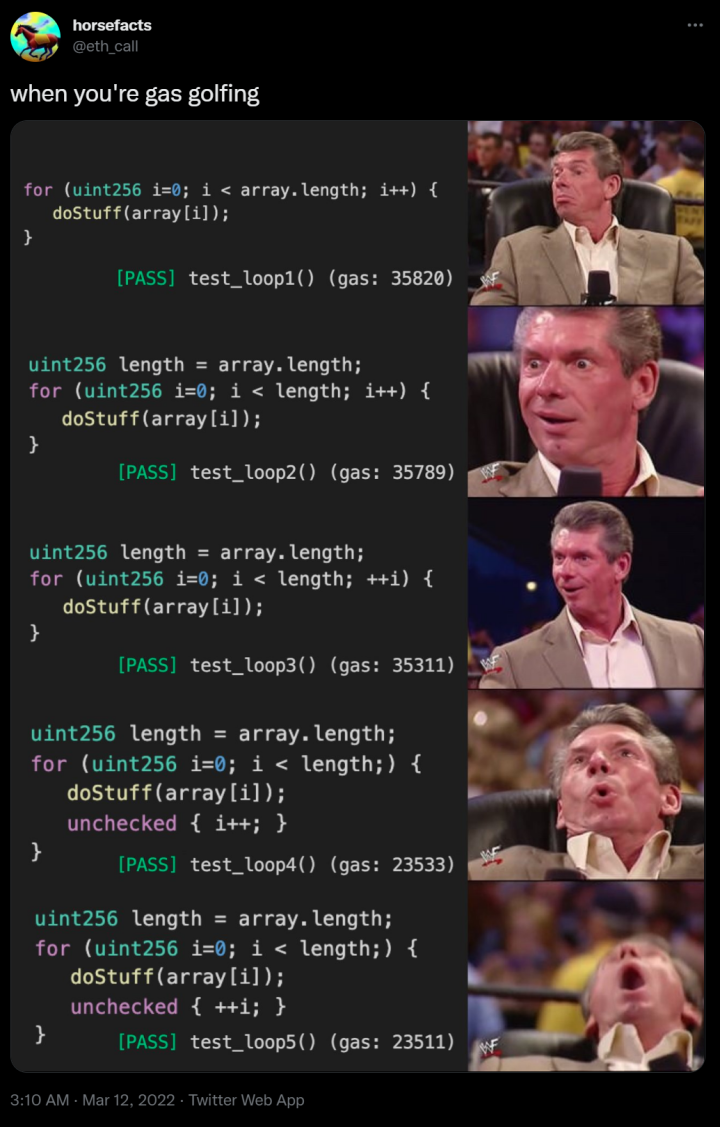
to liquidate
Money markets like Aave, Compound, and Maker allow users to deposit certain assets as collateral and borrow others. As the value of collateralized assets fluctuates, users' borrowing power also fluctuates.
These protocols rely on market participants to liquidate a borrower if they borrow more than they are allowed to. But market participants do not do liquidation for free. To incentivize market participants, the protocol charges borrowers a liquidation fee and provides a portion of the fee to the liquidator.
This is where the MEV opportunity lies. Seekers would race to monitor the positions of all borrowers and attempt to be the first to liquidate excess positions, earning liquidation fees.
Similar to arbitrage, liquidation is highly competitive. Competing liquidations can lead to huge gas fees during market dips. Likewise, the most competitive in the liquidation bid are searchers who can optimize the code.
image description

image description
image description
Source: Qin et al., "sandwich attack”
sandwich attack
Transactions on the blockchain do not happen instantly. When a user sends an exchange transaction, an acceptable price change percentage ("slippage") is defined, which determines the price movement range for the pending transaction.
image description
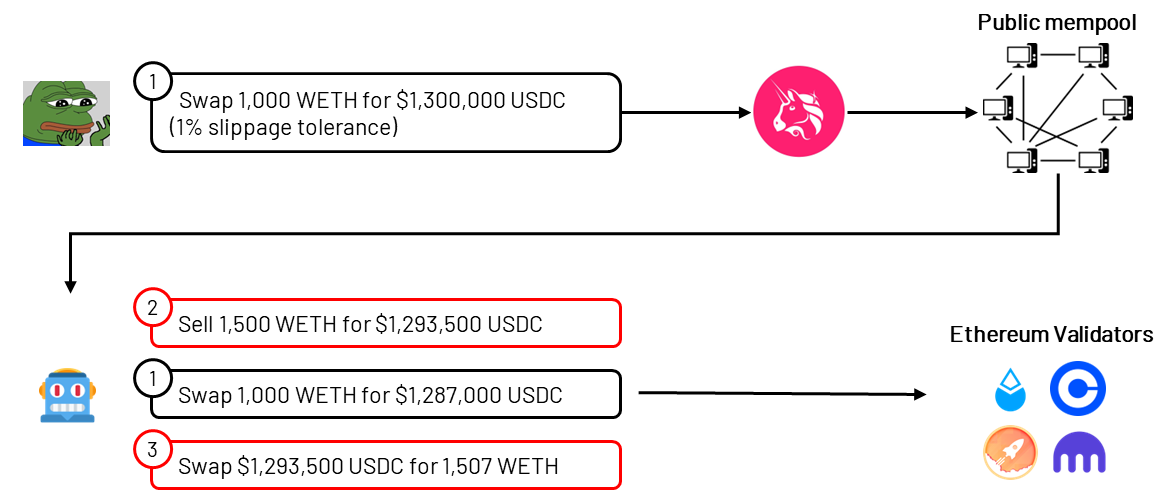
example. A user wants to convert 1,000 WETH to USDC with a 1% slippage. Seeker sees transaction 1 in the public mempool, builds a set of front-running and rollback transactions, and sends them to validators via mev-boost.
As shown in the above example, the sandwich attack relies more on transaction ordering. If either half of the sandwich attack fails to execute, the searcher faces potential losses.
As the name suggests, sandwich attacks are considered vicious MEVs, and most of the crypto community is against them. Although arbitrage and liquidations can also be vicious, sandwich attacks are mostly seen as pure value extraction becauseMost users don't know if and when they'll be caught in the middle. Some searchers have even publicly stated that they will not conduct sandwich attacks-either promise or accept the bad reviews and condemnations that may be incurred.
source
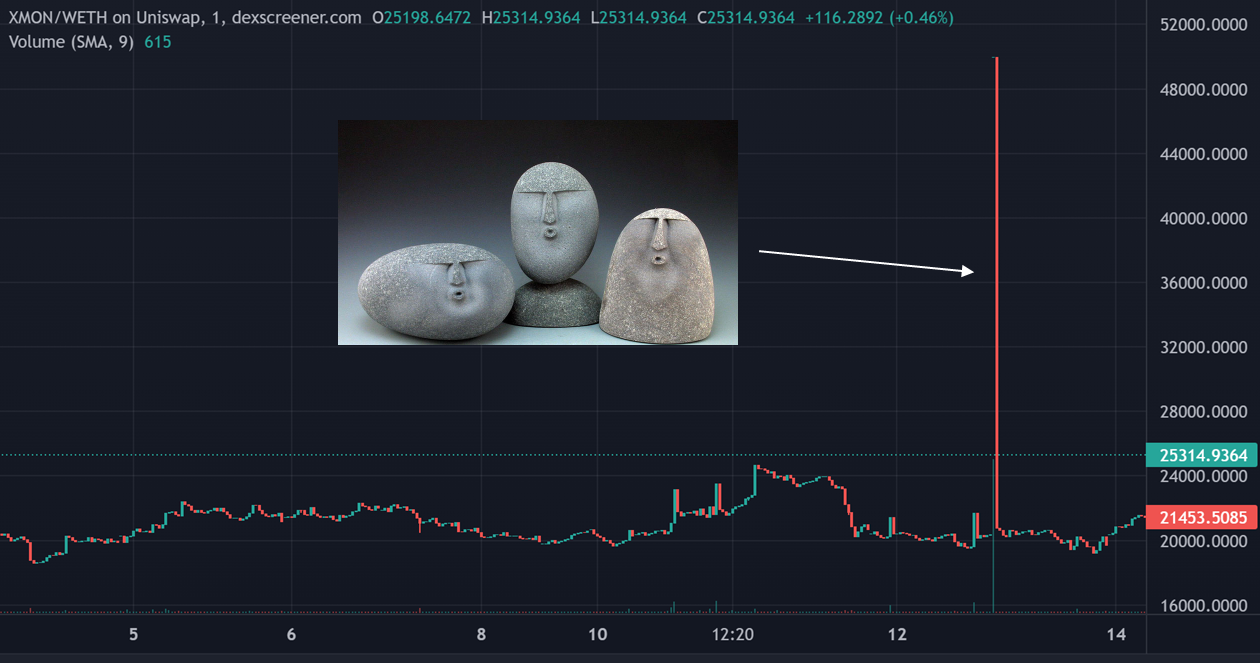
Long tail MEV
Long-tail MEV opportunities abound. Here are some examples:
● Apecoin airdrop:Yuga Labs decided to airdrop tokens to BAYC holders. NFTX is an application that converts NFTs into fungible tokens. A MEV SeekerPurchased all BAYC homogeneous tokens in NFTX, and then redeem the actual NFT with the entire token pool, and receive the Apecoin airdrop, and then re-supply to the NFTX pool. The operating robot earned about 61,000 APE, which was equivalent to about $278,000 at the time. And the bot only spent $310 in gas.
● Fat finger event:someone was carelessList the EtherRock NFT originally priced at 444 ETH at 444 gwei. A bot immediately pocketed it and sold it for 234 ETH — about $600,000 at the time.
● Pick up change on 1inch:1inch occasionally leaves tiny amounts of tokens in their routers for some reason. And there is a MEV robot program that willfor a measly $4Scan your router and get that change.
MEVs matter
We need to understand that MEV is important. MEV affects security, stability, and user experience. MEV is also a key component in enabling blockchain tokens to add value. Most importantly, MEV affects two fundamental properties of blockchain networks: decentralization and censorship resistance.
MEV produces negative externalities
MEV-related activities can have negative externalities. For example, in the absence of an efficient fee market, competition to acquire MEVs may result in optimal gas auctions (Priority Gas Auctions, or "PGA", sometimes called Probability Gas Auctions). During the PGA, Seekers and Bots compete with each other by strategically setting gas fees to drive their own transactions to be included in front (or behind) of certain transactions. This will result in:
● Network congestion, which can cause other transactions to get stuck or go offline
● High and fluctuating gas fees, which will drive other crypto users to quit and be very detrimental to less savvy players
● Bidding fails, which will cause unnecessary consumption of block space (failed transactions will also occupy block space)
source:

source:Finbold
The PGA has also sparked an arms race to eliminate latency, as searchers with lower latency are more likely to win bids. With the advent of Flashbots and other mempool services, PGA became less frequent on Ethereum. However, PGA still often occurs on high-throughput, low-fee chains such as BNB chain, Polygon side chain, and Aurora.
MEV could destabilize the network
More broadly, MEV dramatically changes the incentive drivers for stakeholders in a blockchain network. If motivated enough, MEV interest can even lead validators and miners to engage in malicious activities, such as attempting to perform chain reorganizations. In fact,Some community members have already posted code, so that Ethereum miners can reorganize the Ethereum network to obtain MEV historical income. At the time, Ethereum’s social layer prevented miners from implementing reorgs.
However, this threat has already materialized on other blockchains. in AvalancheApricot Phase 4 UpgradePreviously, any validator could submit a block. After one validator submits a block containing an enticing MEV reward, another validator can "steal" MEV by publishing a longer blockchain. So a chain reorganization race emerged. Obviously, this hurts the usability of the blockchain platform. Even today, other blockchains experience deep reorganizations on an almost daily basis, possibly driven by MEV.
image description
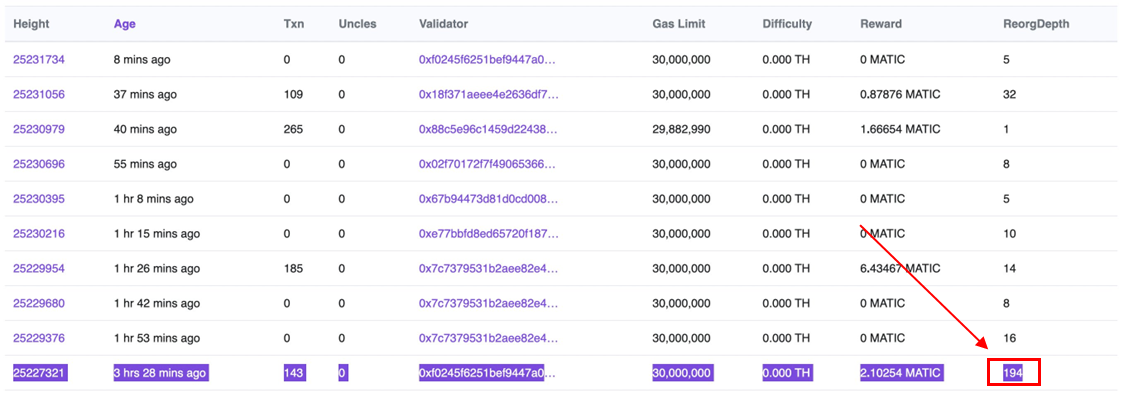
Source: Polygonscan,@Dogetoshi
In addition to restructuring, MEV also facilitates transaction spam on high-throughput blockchains where the fee market is ineffective. For example, spam deals earlier this year led to Solanato interruptnetworkto interrupt. Due to the large amount of economic activity on Solana and the low transaction fees, Seekers cannot be rewarded by ordering transactions, which incentivizes Seekers to send large numbers of transactions to Validators, thereby effectively incentivising Validators.DOS attack, thereby extracting the MEV.
MEV affects all blockchains
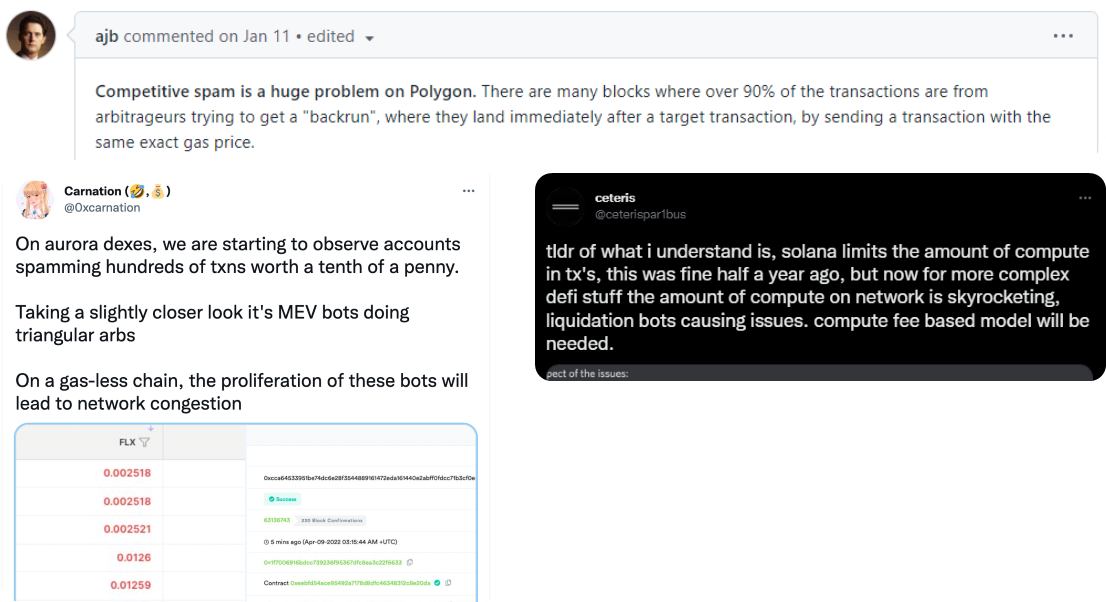
MEV is a centralized force
MEV is the centralizing force on all blockchains.
Block producers can withdraw MEV in two ways. Either capture MEV yourself, or sell the rights to reorder transactions to someone else.
The first way is mainly focused on the validator level. Professional block producers are able to capture MEV more efficiently than individual validators. Complexity brings high returns. Professionals or institutions would be better off investing in infrastructure and human capital to optimize MEV capture. They can also better secure exclusive order flow, provide themselves with a larger portfolio of transactions to build blocks on, or partner with Seekers to gain exclusive access to MEV bundles of transactions. In addition, institutions with larger assets can also use capital-intensive MEV strategies (such as cross-chain MEV).
Therefore, participants have strong incentives to integrate vertically (acquire and run validators with their own searchers) and merge horizontally (combining different MEV search strategies).
In this case, professional verifiers will gradually accumulate higher network equity in the process of making profits. Additionally, if in-protocol delegation is allowed (users can delegate tokens to other validators), this will incentivize other users to delegate their tokens to these validators, further strengthening validator leadership.
In the second way, if the block producers themselves cannot effectively use the MEV strategy, they can also sell the reordering rights to others. Ethereum's roadmap distinguishes between block producers and block builders (Proposer-Builder Separation) for effective planning. This shifts the centralized power of MEV from validators to block builders. However, open questions remain about how to best design such structures.
And, either way, MEV rewards are highly variable. Since most users prefer stable and predictable income, this shift will favor large institutions and validator pools as they will be able to distribute MEV rewards evenly.
image description
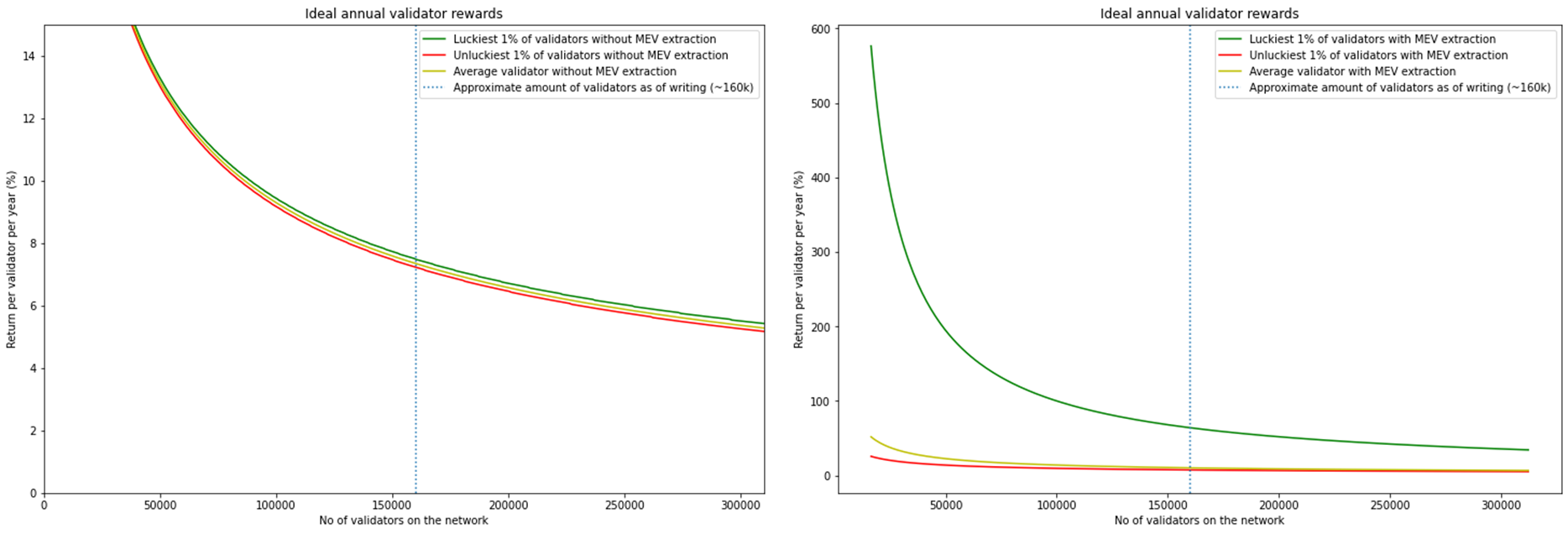
source:
source:Flashbots
Another concern is that MEV profits may grow super-linearly. The MEV in a single block has a linear relationship with the proportion of network computing power or equity. But beyond that, as the dominance of the host network grows, so does the capture potential of multi-block MEVs.
MEVs are important for economic security
However, MEV should not be completely eliminated. MEV income will increase the security budget of the blockchain, and the security of the blockchain must be ensured by extracting MEV. Good actors should also try to extract as much MEV as possible. Otherwise, MEV left on the table will provide malicious actors with a clear incentive to attack the protocol.
This does not mean that blockchain should increase economic security by blindly increasing MEV on the platform. As mentioned above, many types of MEVs introduce negative externalities that impair user experience. If such MEVs continue to increase, users will simply leave the network, reducing fee revenue and economic security. Nonetheless, a certain amount of MEV is unavoidable. This is the result of user activity.
A robust blockchain seeks to design an architecture that democratizes MEV extraction so that every validator can extract MEV at roughly the same rate. As Chitra and Kulkarni in theirA recent studyAn MEV redistribution system, as suggested in , would contribute to increased economic security. Finally, the design should make it easy for new entrants to enter the field, bringing the field closer to perfect competition than to oligopoly.
MEVs can reduce costs
JIT liquidityJIT liquidity, can also substantially improve a trader's execution price. MEV also helps keep algorithmic stablecoins pegged, controls bad debt from money market protocols, and helps enable unique DeFi designs (e.g.Primitive's RMM、Opyn's Squeeth)。
Opyn's Liquidation-Free Multiplied Perpetual Contract Relies on MEV Seekers
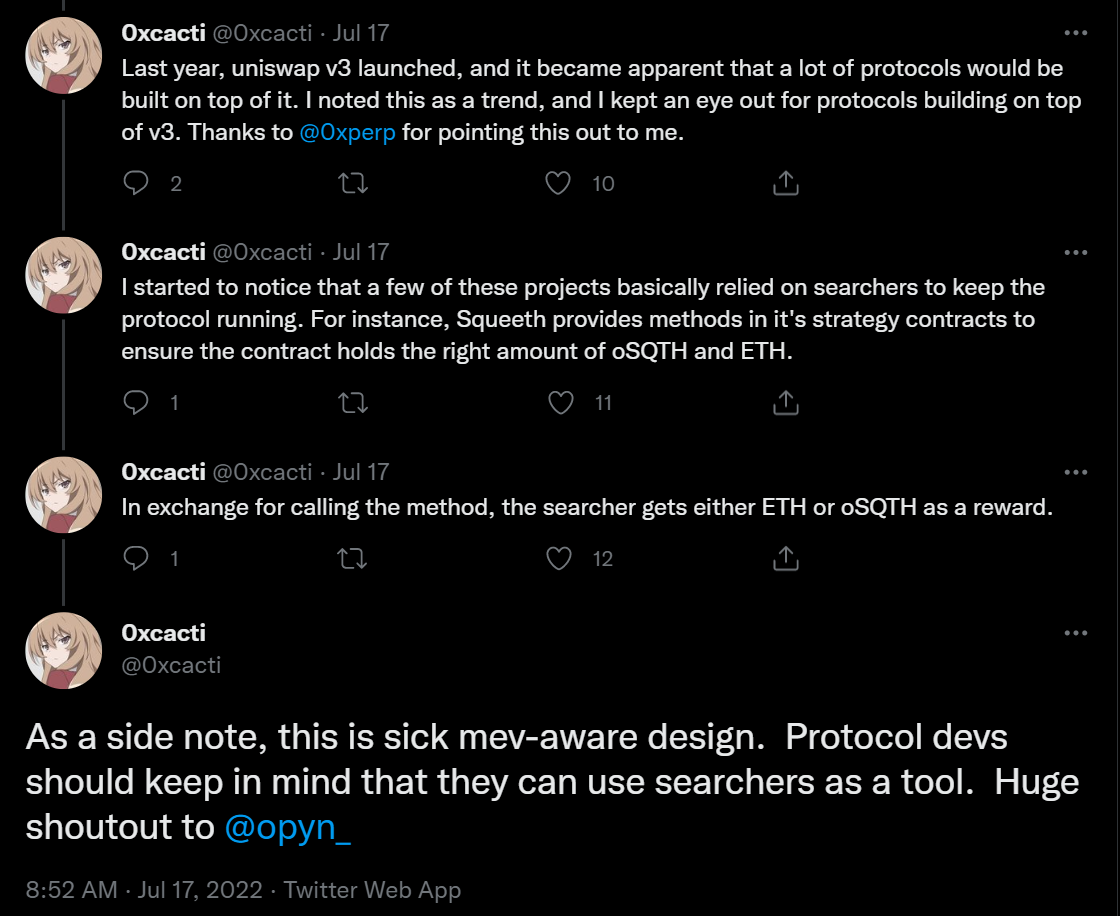
MEV creates token value
The verifier's income comes from minting rewards + basic transaction fees + MEV/priority fees. Minting rewards are effectively a redistribution of ownership, transferring some ownership from passive holders to stakeholders. In most cases, the base transaction fee should be close to zero.
Therefore, we believe that the core long-term value of L1/L2 tokens lies in currency premium (eg BTC, ETH) and/or realized through MEV. Fundamentally, blockchains are selling block space. Larger MEV opportunities bring higher demand for block space.
Therefore, platforms need to carefully consider the MEV they generate and capture so that no value is lost.
Below, we list some current protocol design examples for capturing MEV and internalizing MEV:
● Optimism - Auction of MEV.Optimism is an L2 solution on Ethereum. Currently, it determines trade order flow by running a centralized sorter. According to the latest disclosure, Optimism is preparing to run an MEV auction for the right to reorder transactions within the N-block window, which will be auctioned to the highest bidder. Excess profits from these auctions will be used for protocol building through retroactive public goods funding.
● Aurora - Manage and internalize MEV order flow.Aurora is deployed onNEAREVM smart contracts on . Initially Aurora provided gas-free transactions until its network was constantly attacked by transaction spam. Aurora recentlyAnnounced a MEV program, the program will manage MEV streams to mitigate spam attacks and Sybil attacks. Aurora is working withKolibr.ioCollaborate to check MEV opportunities before transactions go to the public mempool, creating an open and competitive market for order flow payments.
● Osmosis - Minimizes MEV and captures MEV.Osmosis is a Cosmos DeFi application chain aimed at long-term MEV mitigation through threshold encryption. Osmosis has also deployed a system that is able to “solve MEV itself” — such as arbitrage after large transactions — so that profits flow to Osmosis stakers.
● Cosmos - Establish a cross-chain block space market.Cosmos is an internet of blockchains that forms the foundation for several important blockchains, including BSC, Polygon, and Cronos. But the common criticism of it is that its native token ATOM does not reflect the contribution value of Cosmos. recent,In order to improve the value accretion of Cosmos, community members put forward a new proposal. The proposal includes a cross-chain scheduler, which would create a cross-chain blockspace marketplace that would generate revenue from cross-chain MEV activity.
MEV will grow
As complexity increases, MEV will grow, and we expect MEV growth to be exponential over the next decade.
Even on Ethereum alone, the growth of MEV has changed since the release of Flash Boys 2.0 due to the growth of new protocols and primitives. The rise of a new asset class (NFT) and various financial experiments related to it has also led to the emergence of more MEV vehicles.
This trend is bound to continue.The blockchain network is a double-edged sword, it brings an unlimited and decentralized smart contract platform, and it brings more MEV.
This trend is also exacerbated by the emerging multi-chain world. MEV already exists on each chain individually. But since different blockchains have different trust assumptions, there will always be additional MEVs at each chain boundary.
There are no solutions, only trade-offs
To better understand MEV dynamics, we break down the blockchain into the following three fundamental elements:
● Virtual Machine (VM):The VM determines the dimension - what the protocol can do. A virtual machine can have extremely limited functions, or it can be so powerful that it is Turing complete. As mentioned above, higher complexity will bring more carriers to MEV. Getting any developer to deploy smart contracts capable of holding billions of dollars in value would be a double-edged sword.
● Consensus mechanism:A fundamental property of a blockchain is consensus on the validity of transactions and the order in which they are executed. Encrypted records are created to prove that transactions are valid and to show us the state of the blockchain world. But at the same time, there are a lot of people trying to change the state of the world. There will be some users who come up with a higher preference and are willing to spend money to secure that preference.
● Block space market:Block space is limited. The market needs to allocate block space efficiently. Given the above factors, if the marketplace is poorly designed, users will go off-chain to ensure ordering preferences.
We believe that MEV will emerge as long as the blockchain allows anyone to deploy smart contracts and transfer value due to the above factors.
Therefore, we believe that rather than thinking about how to eliminate MEV, it is better to think about how to manage MEV in the above three dimensions and make corresponding trade-offs. Here are some considerations for each factor:
Block space market
Perhaps the most attainable goal of MEV governance is to design a proper market for block space. Small design changes can make big changes in user experience and externalities (see:EIP-1559)。
It will be necessary to learn from the role of different designs in major market events, such as violent cryptocurrency sell-offs or popular NFT minting. Among these events, ordering preference is the most important.
As the table below shows, most markets that lack an efficient auction mechanism create incentives for entities to spam transactions on-chain. For example, if winning the MEV opportunity means millions of dollars in profit, and the chain determines ordering on a "first come, first served" basis, then Seekers will not hesitate to send thousands of spam transactions to Validators to secure this profit.

The block space market also determines the dominant strategy of MEV, and therefore, determines where the "power of centralization" of MEV will be directed.
consensus mechanism
Encrypted memory pools are one of the more promising solutions to contain harmful MEVs. But how to do this effectively is still a topic of debate.
For example, the DeFi application chain in the Cosmos ecosystemOsmosisplan to passThreshold Encryptionto reduce harmful MEVs. Transactions are encrypted once they enter the mempool, thereby hiding transaction information from censorship or ordering. All validators share the private key used to decrypt the information. Blocks are only decrypted after they are finalized.Shutter NetworkSuch a solution is also being developed for Ethereum Rollup. And on Ethereum, Flashbots has explored the use of trusted hardware (MEV-SGX) instead of encryption to achieve a similar effect.
Latency is the key tradeoff here. Threshold cryptography is bandwidth-intensive, especially when the committee of validators sharing the encrypted information is large and dispersed. Even using trusted hardware like SGX introduces additional latency to the system. These systems also introduce increased complexity, greater technical risk, and additional trust assumptions to the protocol.
Other considerations for the consensus mechanism include:
● ImplementationSingle Secret Leader Election, to prevent DOS attacks induced by MEV
● Single Slot Final Confirmation,Mid-term final confirmation, the probability of final confirmation
● Embody the separation of block builders and committers in the protocol itself (e.g. Ethereum's Proposer-Builder Separation)
virtual machine
Limiting the capabilities of a virtual machine cuts down on MEV. For example, the Bitcoin network has limited functionality and a fairly limited breadth of applications built on top of it, so the least amount of MEV exists on the Bitcoin network.
Developers could also create a permissioned platform that lets the blockchain specialize in specific verticals and help manage user experience. For example, Osmosis and Sei are blockchains built for DeFi. Developers need to submit proposals and get approval to deploy smart contracts. This greatly reduces MEV vectors.
Current status of MEVs
The role of Flashbots in shaping the Ethereum MEV landscape has increased significantly. More recently, the crypto community has been at work trying to address order flow and block building issues following the U.S. Treasury Department’s sanction of the Tornado Cash smart contract and its associated addresses. Below we detail the origins of Flashbots, its pre- and post-merger designs, and why censorship issues have only recently arisen.
The Origin of Flashbots and MEV-Geth
Flashbots is a research and development organization established in July 2020 to mitigate the negative externalities of MEV.
The agency launched "MEV-geth" in 2021 to create an off-chain non-public transaction pool for Ethereum that conducts a sealed auction of Ethereum block space. It allows searchers to create and send "bundles". The searcher can set the transaction execution conditions in the bundled transaction package. Notably, the system allows the execution of atomic transaction packages. Either all transactions complete execution, or none of them execute. This is especially beneficial for certain types of transactions, such as sandwich attacks.
Seekers send bundles to Flashbots' relayers. Relays are used to validate bundled transactions and mitigate Denial of Service (DOS) attacks. Validated bundled transactions are then sent to miners. Miners can evaluate all bundles they have received and pick the most profitable bundle to create a block.
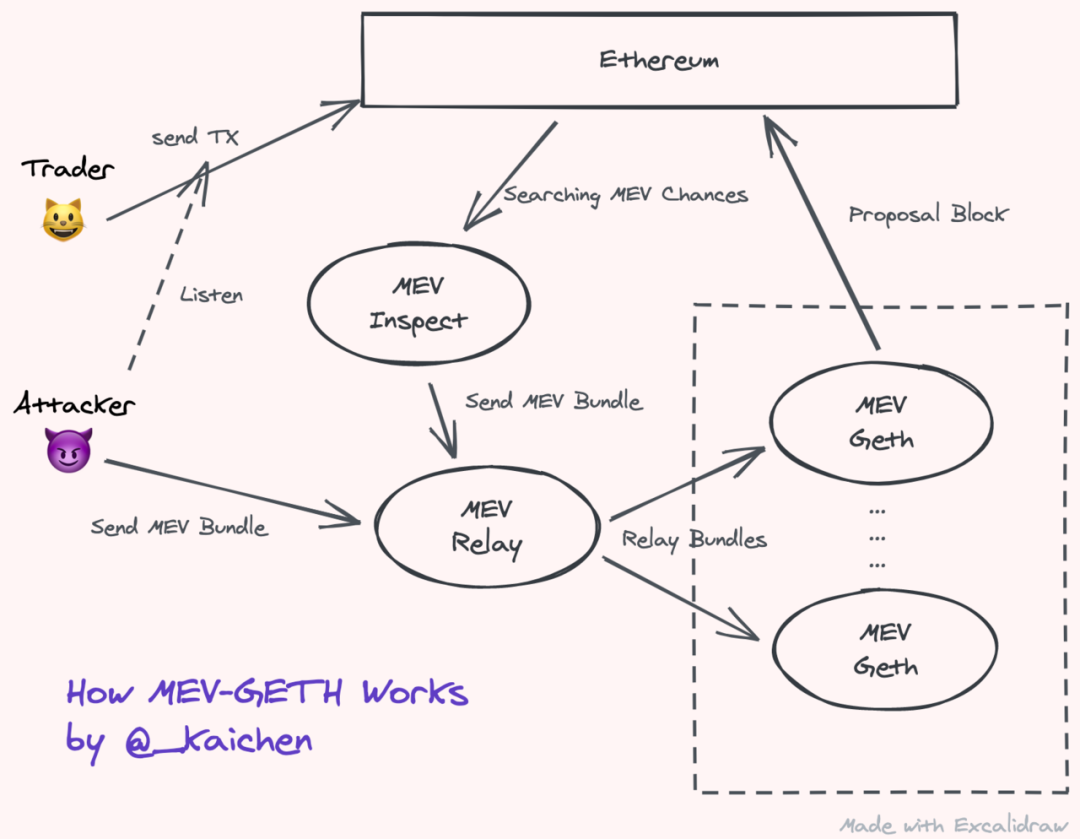
The advantages of this architecture include:
● Privacy- Transactions are not made public until they are included in a block. Failed transactions will not be made public. There is also no gas fee for failed transactions. As a result, there will be no bots identifying and front-running MEV opportunities, and searchers can capture MEV with more confidence.
● Efficiency- This architectural design creates an efficient market for MEV opportunities. The most obvious MEV opportunities will result in highly competitive bidding to avoid unnecessary consumption of on-chain resources. New entrants, on the other hand, are free to enter the market by taking advantage of long-tail or niche opportunities.
One thing to note is that the above architectural design is not a trustless solution. Both relayers and miners can view bundled transactions submitted by Seekers. It is also possible for them to steal deal bundles (stealing allegedly did happen). However, this reputational cost is also part of the complete system.
MEVs in PoW
source:
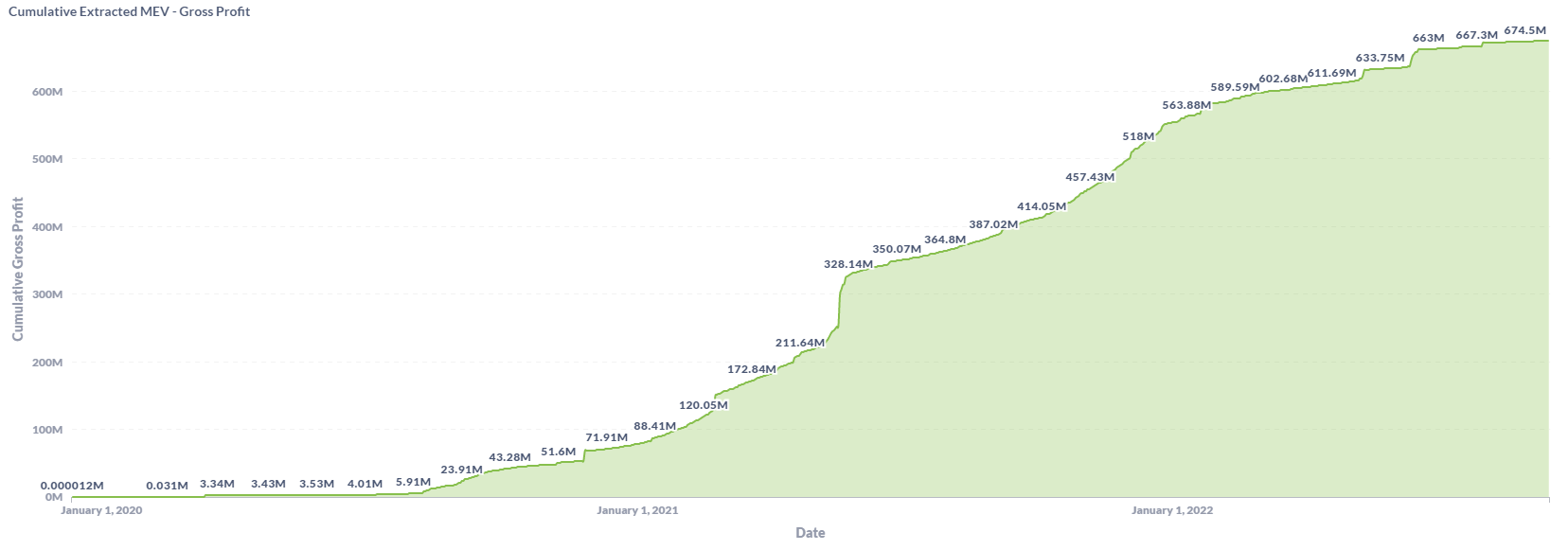
source:Flashbots Explore
Additionally, Chorus One estimates that since August 2020,Sandwich arbitrage brings in nearly $1 billion in profits.Over the same period, Messari estimates that ethereum miners earned about $28.9 billion in total.
This shows that from 2020 to Ethereum merger,MEV accounts for at least 5.8% of the total revenue of miners.
Looking at MEV extracted by sandwich arbitrageurs provides a glimpse into the competitiveness of MEV: MEV extracted by the top five MEV bots accounted for approximately 57.5% of the total extracted value of MEV.
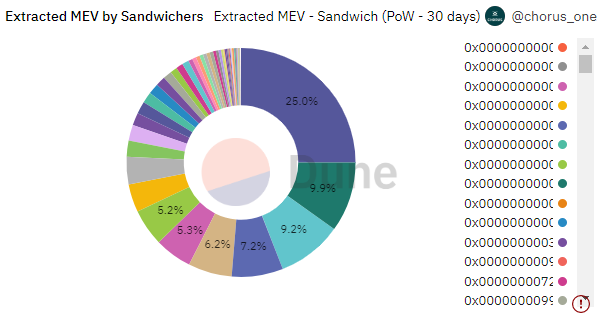
Promoting MEV under the PoS mechanism
The architectural design of MEV-geth lost its function after the merger of Ethereum. In Ethereum under the PoW mechanism, only a few mining pool operators dominate the computing power. Any operator who "cheats" by stealing the Flashbots bundle may be penalized (for example, will not be able to receive order flow in the future). For most miners, it is not worth the risk of losing business to cheat.
After the Ethereum merger, anyone can become a validator. Previous designs of MEV-geth will not work. If bundles of transactions are sent to individual validators, there is occasionally an incentive for validators to steal high-priced MEV transactions as their own. Punishment will not stop this behavior either. Furthermore, as mentioned above, when validators are both block builders and block submitters, they become a centralized force - individual operators cannot match the efficiency of institutional operations in building optimized blocks business.
Thus, the concept of a specialized "block builder" was born, and Flashbots launched the merged MEV solution "MEV-boost". Block builders only focus on receiving transactions and building optimized blocks. The block builder then forwards the block to the relayers.
MEV-boost aggregates repeaters. It identifies the most valuable blocks and hands them off to block submitters.
image description

Source: Flashbots
The verifier can receive all the blocks sent by the block builder through the repeater by subscribing to the message, and get rewards. These block information is protected - validators cannot see transactions before they are sent to the network, and validators risk being fined if they try to steal MEV.
Ultimately, this architecture mitigates the effect of MEV making validators a centralized force. Instead, the architecture pushes the power of centralization to the block builders.
review and filter
This new architecture also introduces new censorship bottlenecks. Only a handful of entities operate relayers and block builders, and some of these entities must also comply with local regulators. It is worth noting that,Some relayers and block builders filter out OFAC-sanctioned addresses, including Flashbots own relayers and block builders.In fact,

In fact,Only 3 relayers do not censor transactions, and they only account for 12.5% of the MEV-boost market share.
Why is the issue of censorship gaining attention only now? Under the PoW mechanism, censorship issues are not prevalent in Ethereum because mining pools act as block builders. Even if Flashbots are trying to censor transactions, these miners can still add censored transactions after Flashbots have bundled transactions.
image description

Source: mevwatch.info
Overview of Repeater Operators
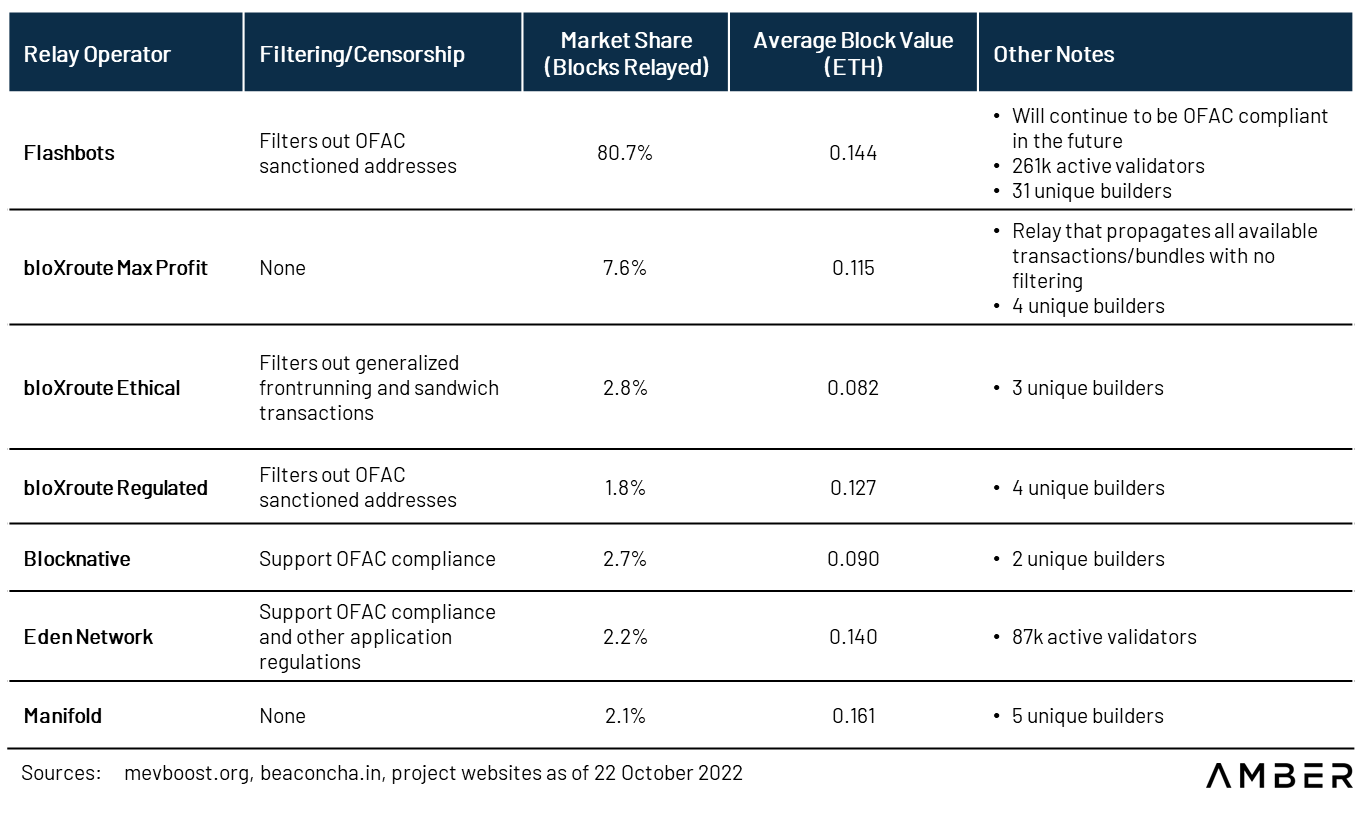
Future trends and open questions
Cross-chain MEV
Suppose there is a price difference between Uniswap on Ethereum L1 and Uniswap on Arbitrum. ETH is priced at $1,400 on Ethereum but $1,300 on Arbitrum. How to arbitrage?
1. Official cross-chain bridge: Buy 1 ETH on Arbitrum, and then use Arbitrum's official cross-chain bridge to transfer ETH to Ethereum's L1, which will take 8 days. Hopefully the price will not be too volatile by then (or use perpetual futures contracts to hedge). Then sell on Ethereum L1.
2. Third-party cross-chain bridge:source:
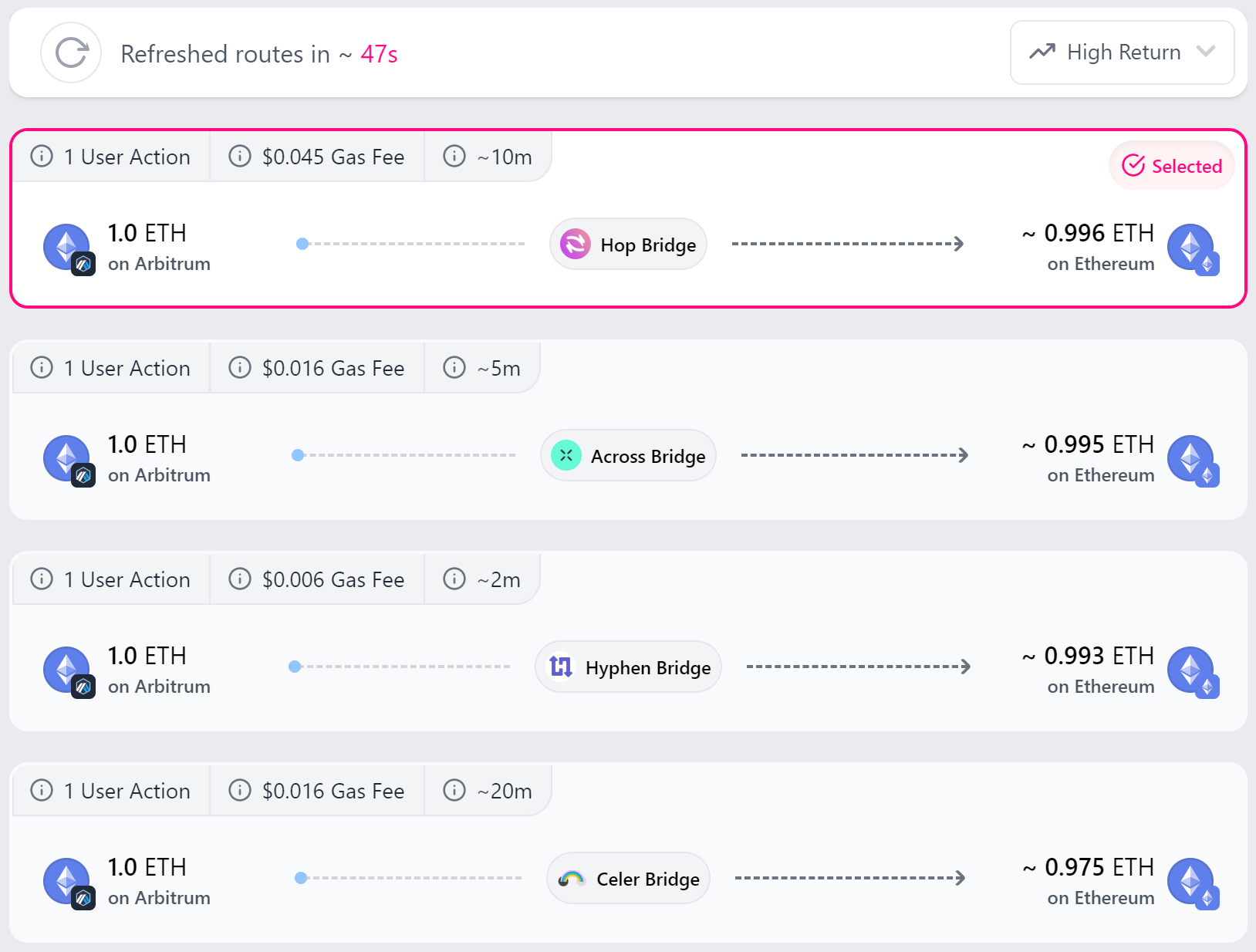
source:Bungee Exchange by Socket
3. CEX:Some exchanges accept deposits directly from Arbitrum. There is a time lag between deposits and withdrawals, but roughly between 5-20 minutes.
4. Cross-chain arbitrage of own assets:Hold ETH and USDC on both chains at the same time, and arbitrage between the two chains can be carried out when opportunities arise. From time to time, the amounts of the two assets on both chains are rebalanced to ensure that there is sufficient stock of funds on both chains.
Clearly, option 4 captures almost all opportunities. But this strategy is also the most capital-intensive option available to professional market makers and institutions.
In fact, this trend also provides an incentive for cross-chain collusion to engage in speculation. Cross-chain extraction of MEV is probabilistic. So a single institution can minimize risk and capture MEV more efficiently by deploying validators on multiple chains.
Unanswered questions:
● How will the vertically integrated entity participate in the market? Potential synergies can be considered between centralized exchanges such as Binance or Coinbase and on-chain operations (withdrawals, deposits, running validators, etc.). Or synergy between traders and cross-chain bridges (Jump and Wormhole, Alameda/FTX and Layer Zero/Stargate, etc.).
● Can a cross-chain bridge with liquidity on several chains capture part of MEV by itself?
● How will the centralized chain affect the decentralization of other chains? For example, BNB verifiers can be in a favorable position among Ethereum verifiers and continue to gain higher rights and interests in the network over time.
Multi-block MEV
Given PoW, multi-block MEV was not realistic on the previous Ethereum. Because no one knows in advance who the next block submitter will be.
However, after the Ethereum merge, anyone knows the committers of 32 blocks in the next epoch. There are currently over 445,000 active validators, so at first glance it seems unlikely that a single validator would be selected to commit multiple blocks within one epoch, let alone multiple consecutive blocks. However, multiple validators are often affiliated with the same entity or in the same pool. Coinbase alone controls 13% of active validators - making CoinbaseThere is about a 39% probability of committing at least 2 consecutive blocks.
image description

source:Alvaro Revuelta
Note: p represents the proportion of validators, k represents the number of consecutive blocks
The biggest threat posed by multi-block MEV may beBy manipulating the TWAP price oraclesource:

source:Twitter
But this is just a carrier, and we have not seen what other operations can be performed by multi-block MEV, especially the submission of consecutive blocks. Five consecutive blocks means that one entity can control block production for a full minute on Ethereum.
Unanswered questions:
● What other attack vectors exist for multi-block MEV?
● What measures can be taken to prevent the emergence of multi-block MEV?
PFOF and Transaction Flow Auction
In conclusion, user intent and transaction flow are the main sources of MEV opportunity. Therefore, we can reasonably envision wallets or applications or streaming auction transactions to block builders. Wallet, application, and infrastructure providers will be well-positioned to benefit from order flow aggregation and order flow auctions, which provide them with another avenue to monetize.
Unanswered questions:
● How to design an efficient auction market to prevent the block builders and searchers who control the exclusive order flow from becoming more centralized?
epilogue
epilogue
At first glance, the outlook seems bleak. The structure of the cryptocurrency market seems to be increasingly like traditional finance: transactions all go into a black box managed by privileged intermediaries, and the results all come out the other end of the black box.
Fortunately, we are seeing more and more people getting involved in the MEV space, some discussing what is fair in the space, some digging into proper market design options, and some actually adopting solutions To alleviate the MEV of the entire supply chain.
Even though this is a long report, we have only scratched the tip of the MEV iceberg. Below we list some additional resources for readers interested in learning more about related topics.
If you want to discuss related topics with us, you are also welcome at any timethank you。
thank you
Special thanks toFlashbots、Shutter Network、Alkimiya、Bryan Zheng、snoopyanddefi guyauthor
author
The author of this article, Steven Shi, is an investment partner of the Amber Group Ecological Fund, which is an early encryption venture fund under the Amber Group.
Additional references:
Reading material:
● Flash Boys 2.0 - Daian et al.: A Groundbreaking Research Report Uncovering MEV and Its Impact on Ethereum
● Ethereum's Dark Forest - Paradigm: A first-hand account of how to dodge front-running traders on Ethereum
● Ethereum Blockspace - How and Why the Market is Allocated - Paradigm: First-principles-based analysis method to help understand the block space market and MEV
● MEV … for what? - Phil Daian: Explore why MEV is fundamental and how to manage it
● MEV Manifesto - Delphi Digital: In-depth discussion of MEV design and solutions on Ethereum
● Optimism's MEVA Proposal: Optimism made the original proposal to auction MEV on L2
● MEVA (What is it for?) - Ed Felten: An Exploration of Why MEV Auctions Hurt User Experience and Increase Centralization
● Formation of cross-domain MEVs - Obadia et al.: Research on how cross-domain MEVs are formed
Resource library:
● MEV.wiki: Public wiki for learning about MEV
● Flashbot's MEV research library: MEV repository
● 0xmisaka's MEV Github code/repos list
● Written by Blockchain at Berkeley"MEV guide"
● Written by 0xemperor"AwesomeMEV"
and
● Flashbots:documentandData Dashboard
● Mevboost.org: Track MEV-boost relayers and block builders
● EigenPhi:disclaimer
disclaimer
Original link